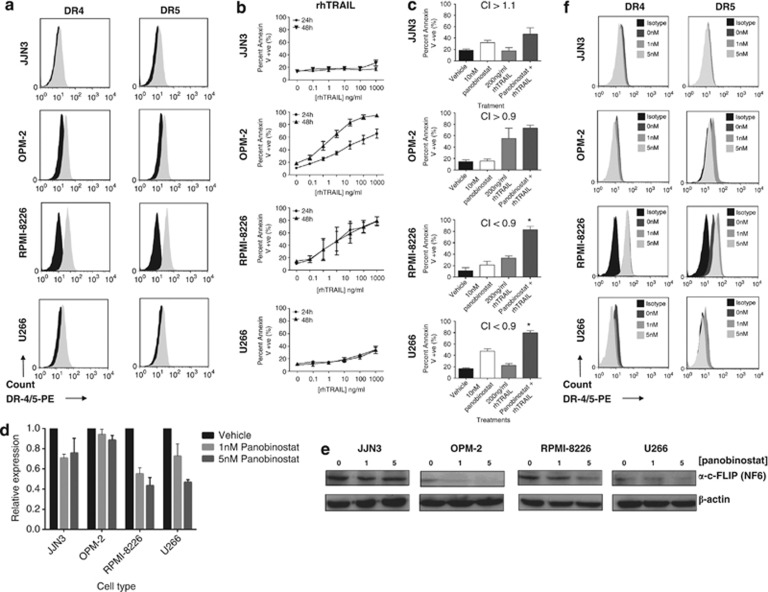Figure 3.
(a) Assessment of cell surface death receptor DR-4 and DR-5 on human MM cell lines JJN3, OPM-2, RPMI-8226 and U266, using flow cytometry against an isotype control antibody (n=3). Black histogram=isotype control; gray shaded histogram=DR4 or DR5 expression. (b) Differential sensitivities of human MM cell lines to rhTRAIL treatment. Single-agent dose–response curves were constructed in human MM cell lines (JJN3, OPM-2, RPMI-8226 and U266) treated with rhTRAIL for 24 and 48 h. (c) Synergistic induction of apoptosis in human MM cell lines OPM-2, RPMI-8226 and U266 following 48 h treatment with panobinostat and rhTRAIL (CI<0.9). The combination of panobinostat with rhTRAIL did not synergize in JJN3 cells (CI>1.1) and was only additive in OPM-2 cells (CI between 0.9 and 1.1). *P<0.05 versus single agents; analysis of c-FLIP (NF6) was undertaken in human MM cell lines (JJN3, OPM-2, RPMI-8226 and U266) following 8–16 h treatment with increasing doses of panobinostat below that shown to induce apoptosis (0, 1 and 5 nM). (d) Panobinostat significantly reduced c-FLIP mRNA expression levels in all cell types (8 h), whereas (e) protein expression was reduced in OPM-2, RPMI-8226 and U266 cells (16 h); and (f) assessment of cell surface DR-4/5 expression on human MM cell lines (JJN3, OPM-2, RPMI-8226 and U266) following treatment (16 h) with panobinostat (n=3). Panobinostat treatment significantly increased DR-5 expression on RPMI-8226 cells while appearing to reduce DR-4 expression on U266 cells (P<0.05). Black histogram=isotype control; dark gray shaded histogram=vehicle control; medium shade of gray histogram=1 nM panobinostat; light shade of gray histogram=5 nM panobinostat. At least n=3 biological replicates were carried out for each assessment

